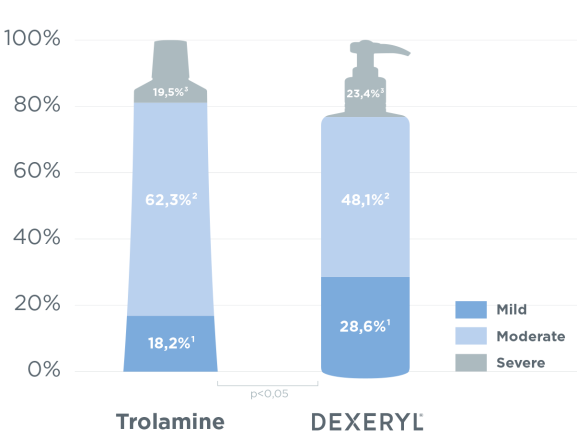- Your skin
-
Our products
Do you know well atopic dermatitis ?
DEXERYL supports you and take care of your dry skin each day
-
CLINICAL RESULTS
- About dexeryl

Statistically significant effectiveness proven in clinical studies on over 1000 patients. These studies were conducted against a placebo or comparator, providing the highest level of scientific evidence
Regular application of Dexeryl Emollient Cream three times a day for 42 days significantly reduced the severity of radiotherapy-related erythema compared to a leading product¹
 Graph showing the intensity of erythema at 42 days, depending on the product used. 1- Minor erythema. 2- Moderate erythema. 3- Severe erythema. Graphic created by Pierre Fabre.
Graph showing the intensity of erythema at 42 days, depending on the product used. 1- Minor erythema. 2- Moderate erythema. 3- Severe erythema. Graphic created by Pierre Fabre.
To compare the activity and tolerability of DEXERYL versus Trolamine in the management of post-radiotherapy erythema.
Phase III, single-centre, randomised (contralateral), double-blind study of Dexeryl cream versus Trolamine 0.67% (reference product).
80 randomised adult patients: 70 with breast cancer/10 with ENT cancer.
3 applications daily.
Duration of 12 weeks: 3 applications per day during the first 6 weeks of radiotherapy and then 6 weeks after it has finished.
Trophic aspect of treated skin surfaces at D42 (end of radiotherapy) assessed by clinical signs (pain, erythema, exulceration, exudation) using a semi-quantitative scale with 4 scores (0=absent, 1=slight, 2=moderate, 3=severe) and a visual analogue scale assessing the overall trophic aspect of the skin (0: skin lesion - 100: no skin lesion)
Tolerance is satisfactory for both products.

Cancer treatments can cause changes to the skin and nails.
How can you take care of your skin to minimise their occurrence?
Sources:
1- Monnier A. Study of the activity and tolerance of DEXERYL cream versus Trolamine in the treatment of erythema resulting from radiotherapy. Clinical study report DC569 B98 CR301.